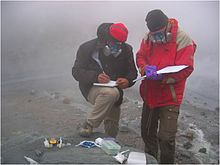- NASA Astrobiology Institute
-
NASA Astrobiology Institute Abbreviation NAI Formation 1998 Headquarters NASA Ames Research Center Location Mountain View, California Director Carl Pilcher Parent organization NASA Budget $16 million (2008) Website astrobiology.nasa.gov The NASA Astrobiology Institute (NAI) was established in 1998 by the National Aeronautics and Space Administration (NASA)[1] "to develop the field of astrobiology and provide a scientific framework for flight missions".[2] The NAI is a virtual,[3] distributed organization that integrates astrobiology research and training programs in concert with the national and international science communities.[4] Since 2006, the director of the institute has been Carl Pilcher.[5]
Contents
History
Although NASA had explored the idea of forming an astrobiology institute in the past, when the Viking biological experiments returned negative results for life on Mars, the public lost interest and federal funds for exobiology dried up. In 1996, the announcement of possible traces of ancient life in the ALH 84001 meteorite from Mars led to new interest in the subject. At the same time, NASA developed the Origins Program, broadening its reach from exobiology to astrobiology, the study of the origin, evolution, distribution, and future of life in the universe.[1]
In 1998, $9 million was set aside to fund the NASA Astrobiology Institute (NAI),an interdisciplinary research effort using the expertise of different scientific research institutions and universities from across the country, centrally linked to Ames Research Center in Mountain View, California. Gerald Soffen former Project Scientist with the Viking program, helped coordinate the new institute.[1] In May,[4] NASA selected eleven science teams, each with a Principal Investigator (PI).[6] NAI was established in July with Scott Hubbard as interim director.[4] Nobel laureate Baruch S. Blumberg was appointed the first director of the institute, and served from May 15, 1999–October 14, 2002.[7]
On 2 December 2010 the Institute announced that it had discovered the first microorganism able to live and reproduce using arsenic. The GFAJ-1 bacterium was found by NASA researchers at Mono Lake in California.[8]
Program
The NASA Astrobiology Program includes the NAI as one of four components, including the Exobiology and Evolutionary Biology Program; the Astrobiology Science and Technology Instrument Development (ASTID) Program; and the Astrobiology Science and Technology for Exploring Planets (ASTEP) Program.[2] Program budgets for fiscal year 2008 were as follows: NAI, $16 million; Grants for the Exobiology and Evolutionary Biology Program, $11 million; ASTID, $9 million; ASTEP, $5 million.[4]
Teams
NAI is a partnership between NASA and its NAI Teams or nodes. Past and present teams are:[9][10]
- Arizona State University
- Carnegie Institution of Washington
- Georgia Institute of Technology
- Harvard University
- Indiana University
- Jet Propulsion Laboratory
- Johnson Space Center
- Marine Biological Laboratory
- Michigan State University
- MIT
- Montana State University
- NASA Ames Research Center
- NASA Goddard Space Flight Center
- Pennsylvania State University
- Rensselaer Polytechnic Institute
- Scripps Research Institute
- SETI Institute
- University of Arizona
- University of California, Berkeley
- University of California, Los Angeles
- University of Colorado, Boulder
- University of Hawaii, Manoa
- University of Rhode Island
- University of Washington
- University of Wisconsin
- Virtual Planetary Laboratory
Research
Selected, significant topics of interdisciplinary research by NAI as of 2008:[4]
- Early habitability of Earth
- The rise of oxygen and Earth's "middle age"
- Snowball Earth
- Microbial mat ecology
- Discovery of the "rare biosphere"
- Sub-seafloor life
- Metal isotope tracers of environment and biology
- Life without the Sun
- Early wet Mars
- Methane on Mars
- Comets in space and in the laboratory
- Exoplanet discovery and analysis
- Modeling exoplanet biospheres
References
- ^ a b c Bunk, Steve (1998-06-22). "Astrobiology Makes Debut Under NASA". The Scientist (Faculty of 1000) 12 (13). http://www.the-scientist.com/article/display/18084/.
- ^ a b NASA Astrobiology Institute (August 31, 2010). "About NAI". NASA. http://astrobiology.nasa.gov/nai/about/.
- ^ J.K.B. (Nove., 2002). "Changes Urged for Astrobiology Effort". Sky & Telescope (Sky Publishing Corporation) 104 (5): 23. ISSN 00376604.
- ^ a b c d e Committee on the Review of the NASA Astrobiology Institute, National Research Council (2008). Assessment of the NASA Astrobiology Institute. Washington, D.C.: National Academies Press. ISBN 0-309-11497-7. http://www.nap.edu/catalog/12071.html.
- ^ "About NAI". NASA. 2011. http://astrobiology.nasa.gov/nai/about/.
- ^ Lawler, Andrew (1998-05-29). "Astrobiology Institute Picks Partners". Science (American Association for the Advancement of Science) 280 (5368): 1338. doi:10.1126/science.280.5368.1338.
- ^ Blumberg, Baruch S. (Nov., 2003). "The NASA Astrobiology Institute: Early History and Organization". Astrobiology (Mary Ann Liebert, Inc.) 3 (3): 463–470. Bibcode 2003AsBio...3..463B. doi:10.1089/153110703322610573. http://www.liebertonline.com/doi/abs/10.1089%2F153110703322610573.
- ^ Brown, Dwayme and Cathy Weselby, "NASA-Funded Research Discovers Life Built With Toxic Chemical", Nasa, 2 December 2010, retrieved on 3 December 2010.
- ^ Teams, NASA Astrobiology Institute
- ^ Former Teams, NASA Astrobiology Institute
Further reading
- Biever, Celeste (2003-07-05). "After a decade in the cold, SETI gets money from NASA". New Scientist (Reed Business Information Ltd) 179 (2402): 8. ISSN 02624079. "NASA Astrobiology Institute awarded the SETI Institute $5 million spread over five years for 10 projects, including one that feeds directly into the search for intelligent life. This project aims to target specific solar systems that are likely to support life, and will use telescopes to screen a type of star called an M-star"
- Dick, Steven J. (2005). The Living Universe: NASA and the Development of Astrobiology. Rutgers University Press. ISBN 0813537339.
- Grymes, Rosalind A. (Jan/Feb 2002). "The NASA Astrobiology Institute: Reaching Within and Beyond". Ad Astra (National Space Society) 14 (1): 12. ISSN 1041102X.
- Lawler, Andrew (2007-01-19). "Astrobiology Fights for Its Life". Science (American Association for the Advancement of Science) 315 (5810): 318–321. ISSN 00368075.
- Mecham, Michael (1999-06-14). "Astrobiology team taking shape at Ames". Aviation Week & Space Technology (McGraw-Hill) 150 (24): 211. ISSN 00052175.
- Sawyer, Kathy (1999). "Out of the Lab, And This World; Hands-On Nobel Laureate to Lead NASA Agency Studying Life's Origins". The Washington Post. p. A17.
Categories:- Research institutes in the United States
- NASA programs
- Astrobiology
Wikimedia Foundation. 2010.

